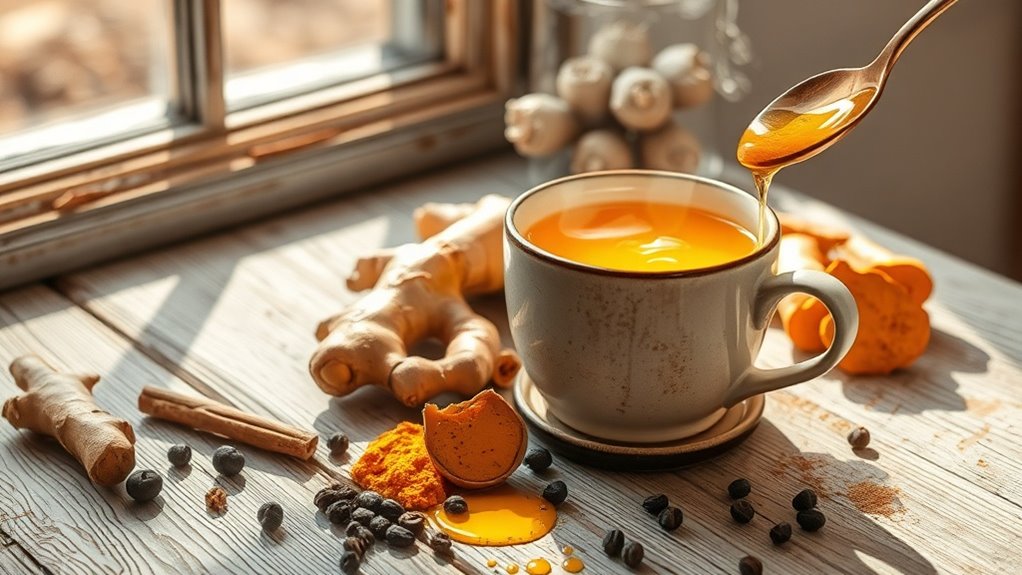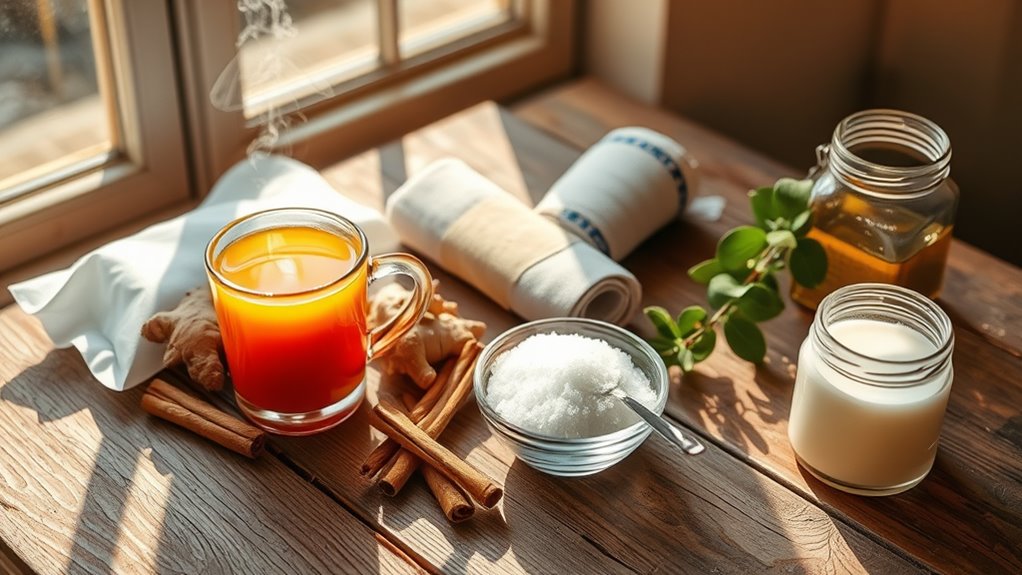The Most Effective Knee Pain Relief I’ve Found Naturally
Understanding Common Causes of Knee Pain
When experiencing knee pain, identifying the underlying cause is crucial for effective treatment. Common causes include osteoarthritis, where cartilage deteriorates over time; patellofemoral pain syndrome, often triggered by overuse; and ligament injuries from sudden movements or impacts.
Inflammation of the tendons, known as tendinitis, frequently affects athletes and active individuals.
Before exploring knee pain relief remedies, you’ll need to recognize whether your pain stems from acute injury or chronic conditions. Your symptoms – such as swelling, stiffness, or sharp pain – can indicate specific underlying issues. Understanding these distinctions helps determine the most appropriate treatment approach. Additionally, considering the effectiveness of natural remedies can play a significant role in managing your knee pain.
Essential Natural Anti-Inflammatory Foods
You’ll find potent anti-inflammatory compounds in colorful vegetables like leafy greens, bell peppers, and carrots that contain high levels of antioxidants to combat knee joint inflammation.
Berries, particularly blueberries and strawberries, provide anthocyanins that can reduce joint pain and improve mobility in your knees.
Research indicates that consuming these foods regularly can lower inflammatory markers in your bloodstream, potentially decreasing knee discomfort over time. Incorporating anti-inflammatory foods into your diet can significantly enhance your overall knee health and pain relief.
Antioxidant-Rich Vegetables Matter
Since inflammation often contributes to knee pain, incorporating antioxidant-rich vegetables into your diet can help reduce discomfort and promote joint health.
Dark leafy greens like spinach and kale contain high levels of vitamin C and E, which neutralize harmful free radicals.
Cruciferous vegetables such as broccoli and Brussels sprouts provide sulforaphane, a compound that blocks cartilage-destroying enzymes.
Red and orange vegetables, including bell peppers and carrots, deliver beta-carotene and other carotenoids that fight oxidative stress.
Purple vegetables like eggplant and red cabbage contain anthocyanins, which studies show can decrease inflammatory markers in joints.
Berries Fight Joint Pain
Because berries contain powerful phytochemicals called anthocyanins, they effectively combat knee joint inflammation and pain. These compounds actively reduce inflammatory markers and oxidative stress in your joints, providing natural relief from discomfort.
| Berry Type | Anti-inflammatory Benefits |
|---|---|
| Blueberries | Highest antioxidant content, reduces TNF-alpha |
| Strawberries | Rich in vitamin C, blocks COX-2 enzymes |
| Blackberries | Contains ellagic acid, fights free radicals |
Research shows consuming 1-2 cups of mixed berries daily can significantly decrease joint pain markers. For optimal results, incorporate fresh or frozen berries into your breakfast or snacks, avoiding processed berry products with added sugars.
Gentle Exercises and Stretches for Knee Health
While medication and rest can help manage knee pain, incorporating gentle exercises and stretches is crucial for maintaining joint mobility and strengthening surrounding muscles.
You’ll want to focus on low-impact exercises like straight leg raises, wall sits, and hamstring stretches.
Swimming and water aerobics provide excellent resistance without stressing your joints.
Perform quad stretches by standing on one leg and pulling your other foot toward your buttocks.
Practice calf raises by standing on a step’s edge and lowering your heels below the surface.
Start with 5-10 repetitions and gradually increase as your strength improves. Additionally, incorporating gentle hamstring stretches into your routine can further enhance flexibility and alleviate discomfort.
Herbal Supplements That Support Joint Function
Several herbal supplements have demonstrated promising effects in supporting joint health and reducing knee discomfort.
Turmeric’s active compound, curcumin, offers potent anti-inflammatory properties that can ease joint pain. Ginger extract helps reduce inflammation and contains compounds that inhibit pain-causing prostaglandins.
Boswellia serrata, or Indian frankincense, has shown effectiveness in decreasing joint swelling and improving mobility.
You’ll find glucosamine and chondroitin sulfate, while not herbs, often combined with herbal supplements for enhanced joint support.
Devil’s claw root and willow bark provide natural pain-relieving properties similar to NSAIDs but with fewer side effects when used properly.
Lifestyle Modifications for Long-Term Relief
You’ll benefit from incorporating gentle, regular movement into your daily routine, as research shows that low-impact exercises like swimming, cycling, or walking can reduce knee pain and improve joint mobility.
Maintaining a healthy body weight through proper nutrition and exercise is crucial since excess weight places additional stress on your knee joints, with studies indicating that even a modest weight reduction can significantly decrease pain levels. Additionally, incorporating anti-inflammatory foods into your diet can further aid in managing knee discomfort.
To optimize these lifestyle changes, it’s recommended to start slowly and gradually increase activity levels while monitoring your body’s response to prevent overexertion.
Daily Movement Practices
Making simple adjustments to your daily movement patterns can significantly reduce knee pain and prevent future complications. Focus on gentle, controlled movements like walking on level surfaces, swimming, or stationary cycling.
When standing, distribute weight evenly between both legs and maintain proper posture. Incorporate range-of-motion exercises that strengthen supporting muscles without stressing joints.
Practice mindful walking by landing midfoot rather than heel-first, and avoid prolonged sitting. When climbing stairs, lead with your stronger leg going up and your weaker leg going down.
These biomechanical adjustments help optimize joint function and reduce unnecessary strain.
Weight Control Matters
While proper movement techniques support knee health, body weight management plays a central role in joint protection. Research shows that each pound of excess weight adds 4-6 pounds of pressure on your knee joints during walking activities.
By maintaining a healthy BMI, you’ll significantly reduce stress on your knee cartilage and supporting structures.
You can achieve optimal weight through a combination of caloric monitoring and balanced nutrition. Focus on anti-inflammatory foods rich in omega-3s, fiber, and lean proteins.
Studies indicate that even a 10% reduction in body weight can decrease knee pain by up to 50% in overweight individuals with osteoarthritis.
Traditional Healing Methods and Their Benefits
Throughout history, traditional healing methods have demonstrated remarkable effectiveness in managing knee pain, with many of these time-tested techniques still holding relevance in modern medical practices.
You’ll find R.I.C.E. (Rest, Ice, Compression, Elevation) remains a cornerstone therapy, while acupuncture’s ability to stimulate specific pressure points can reduce inflammation and discomfort.
Traditional herbal remedies like turmeric and ginger contain natural anti-inflammatory compounds that target pain receptors.
Additionally, ancient practices such as yoga and Thai massage incorporate gentle stretching and joint mobilization techniques that’ve proven beneficial in improving knee flexibility and reducing chronic pain symptoms. Moreover, exploring various therapeutic approaches can further enhance the relief you experience through these traditional methods.
Prevention Strategies and Daily Self-Care Tips
Because knee pain can significantly impact daily activities, implementing preventive measures and consistent self-care routines is essential for long-term joint health.
You’ll need to maintain a healthy weight to reduce stress on your knees and engage in low-impact exercises like swimming or cycling. Proper footwear with adequate support helps prevent misalignment, while regular stretching improves flexibility and reduces strain.
Incorporate joint-friendly nutrients into your diet, including omega-3s and vitamin D.
When standing or walking, maintain proper posture and avoid prolonged periods of immobility. It’s crucial to listen to your body and modify activities that trigger discomfort.







